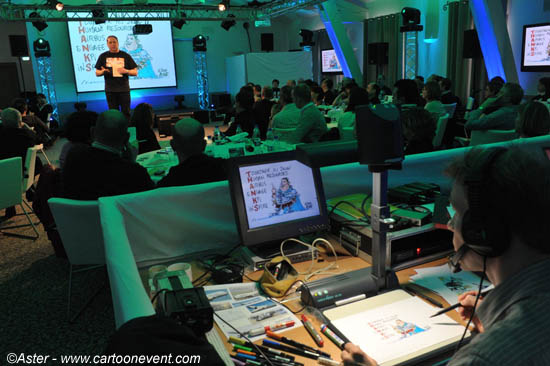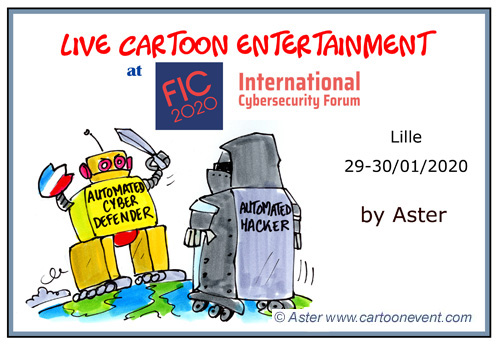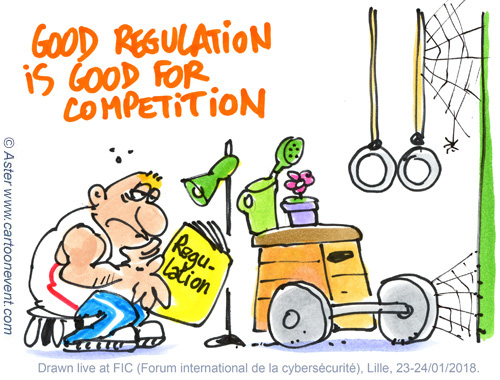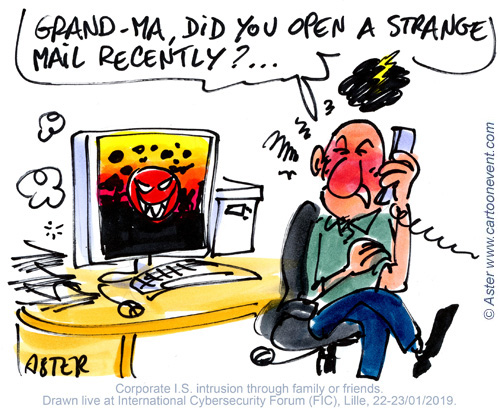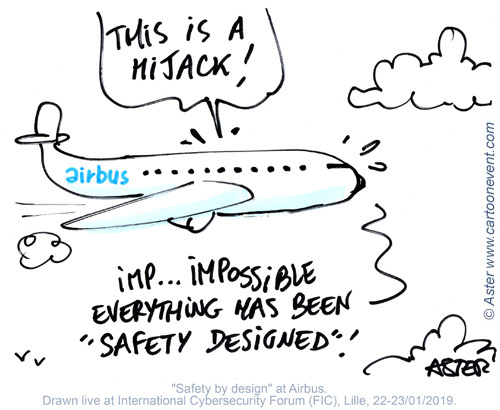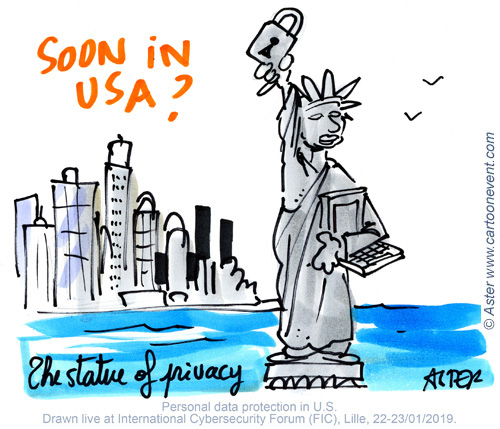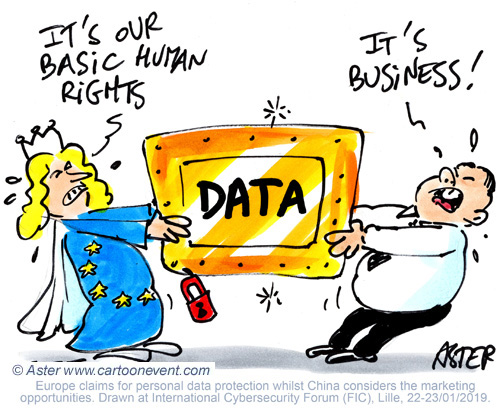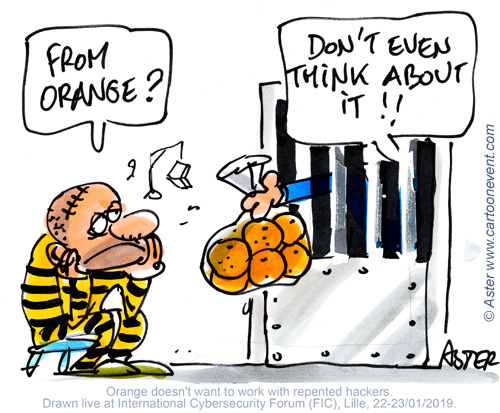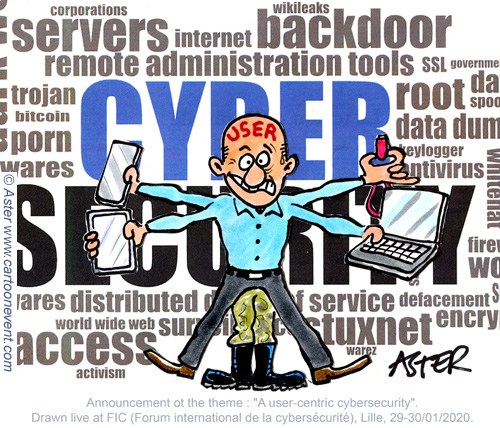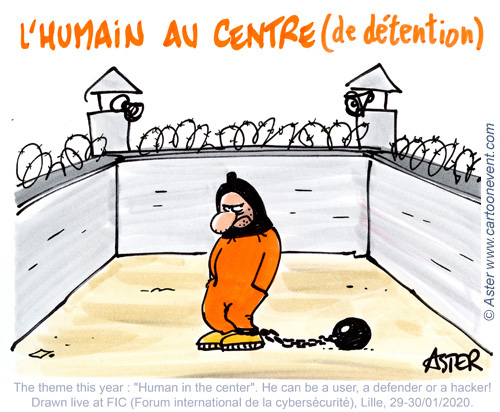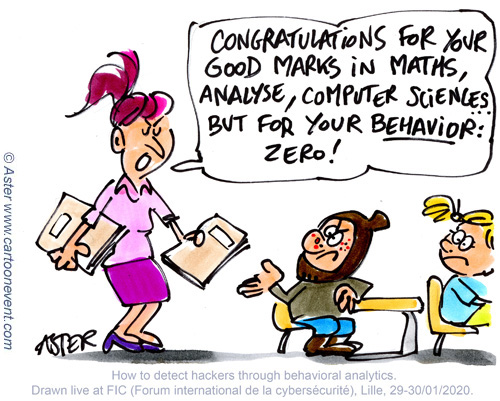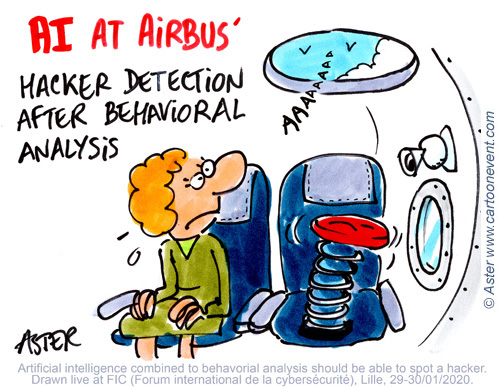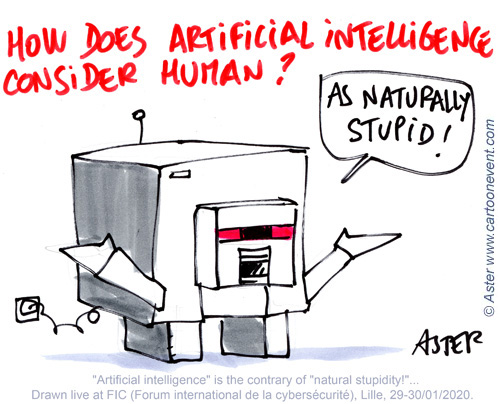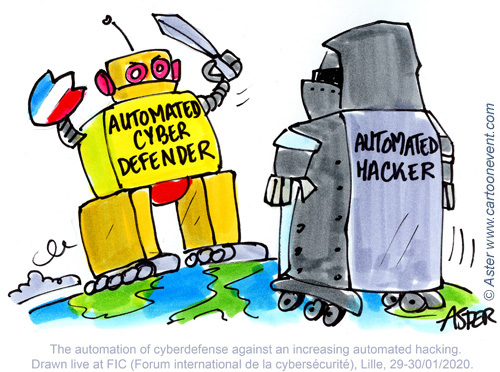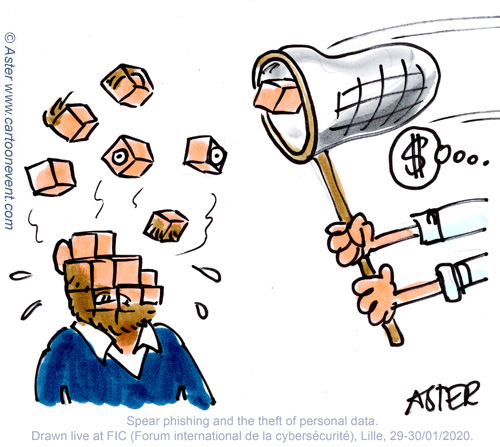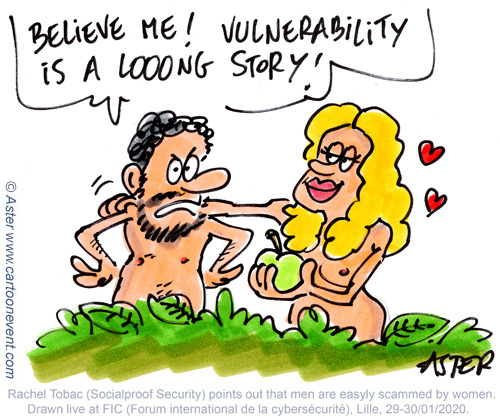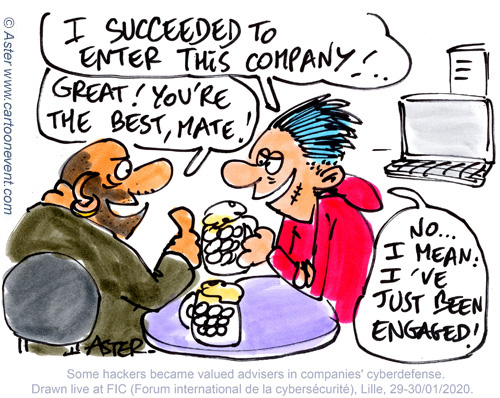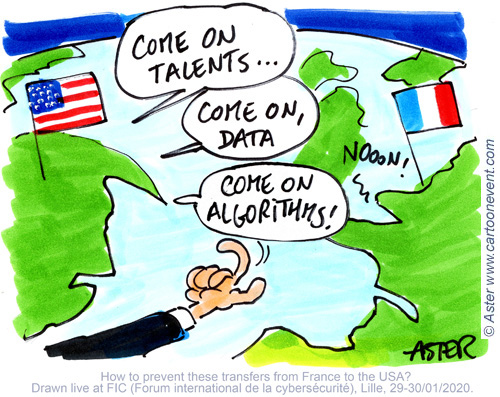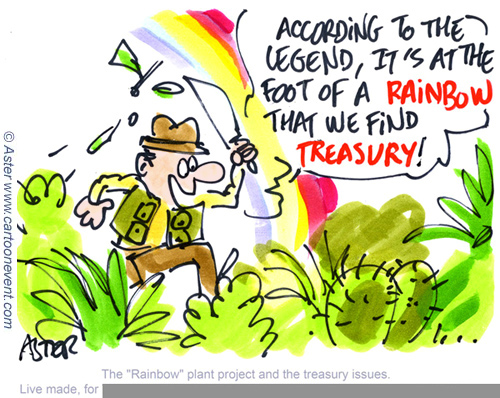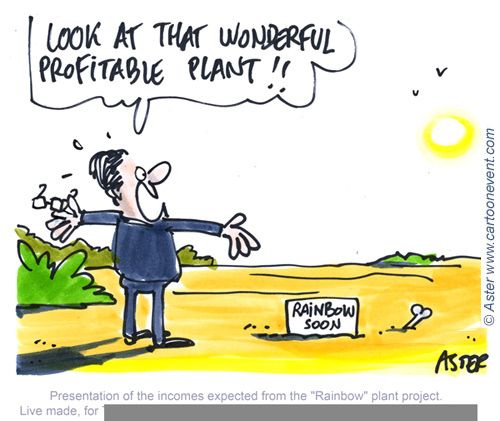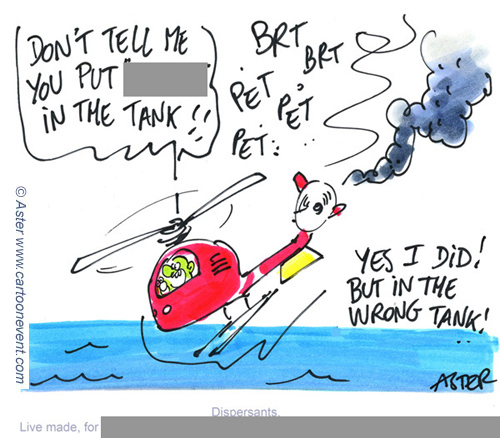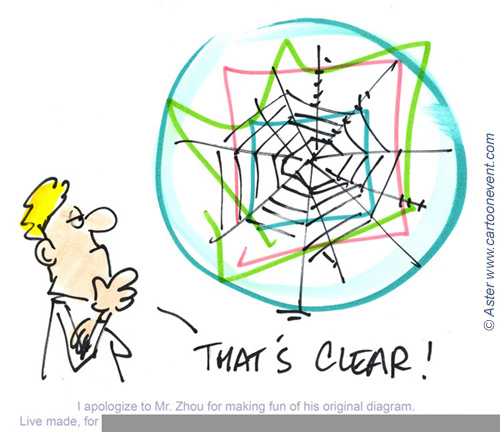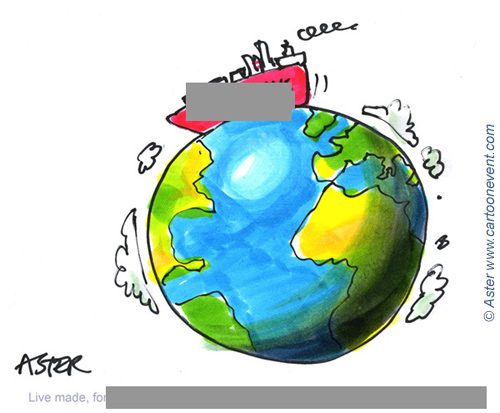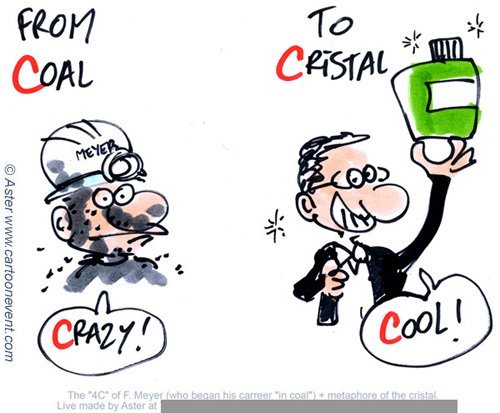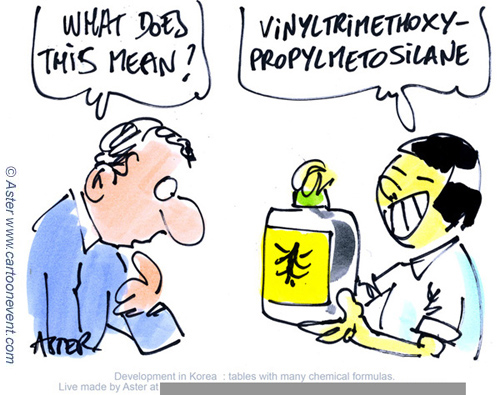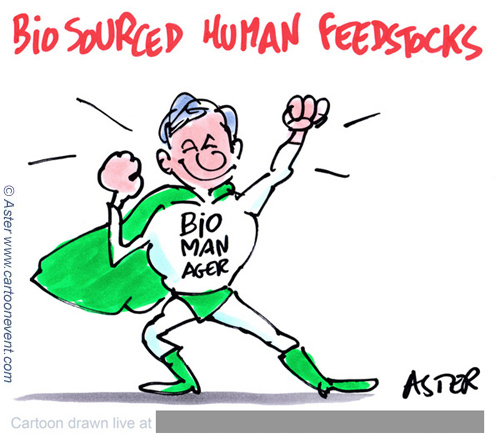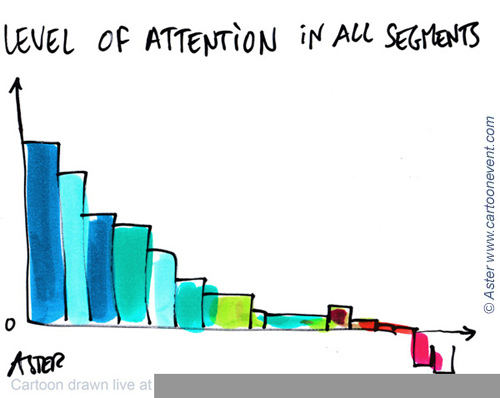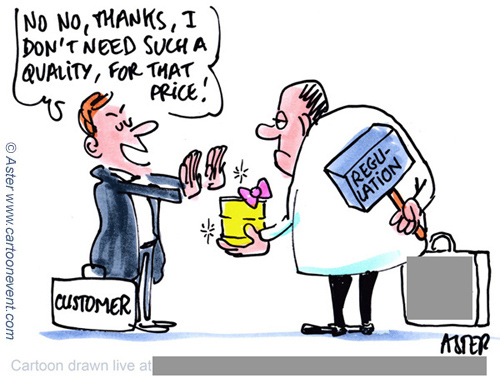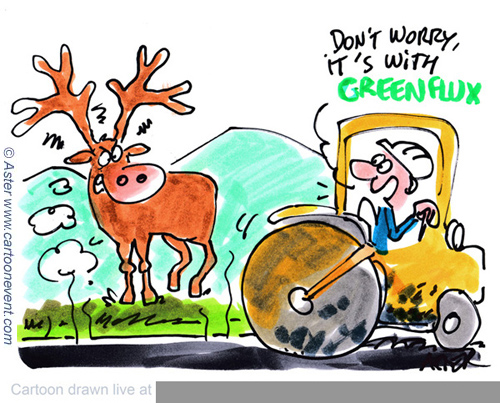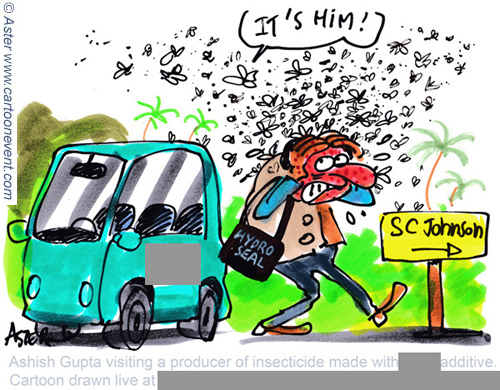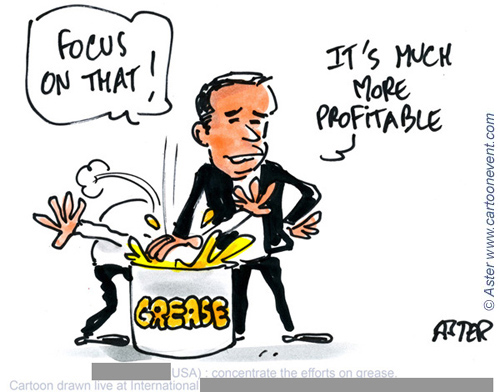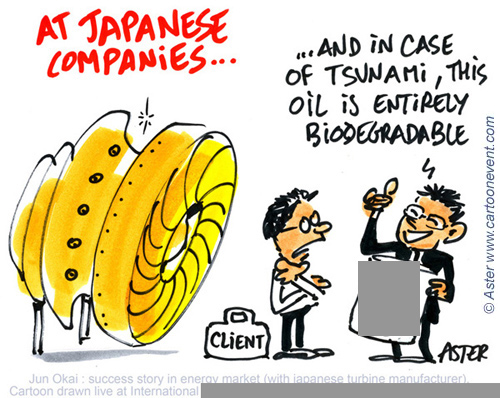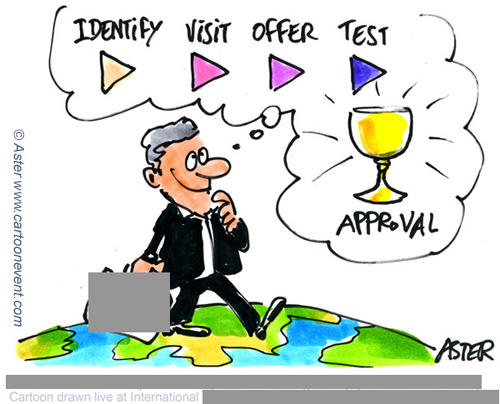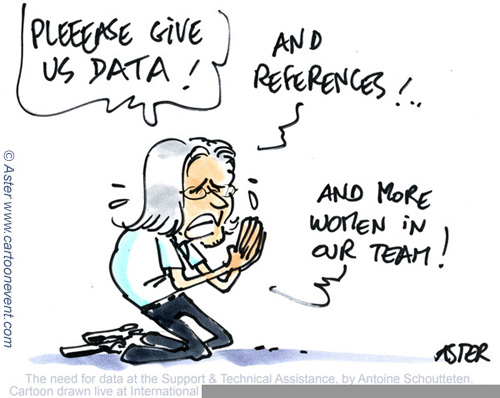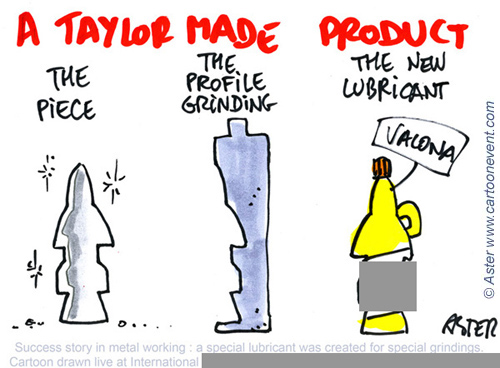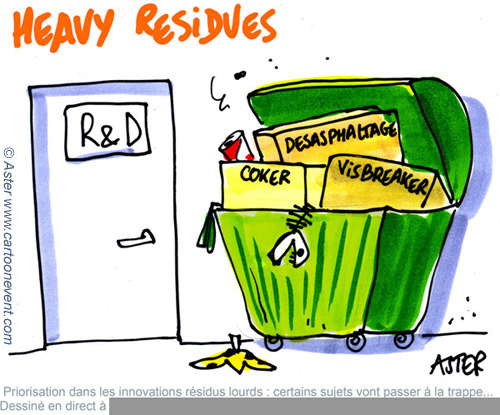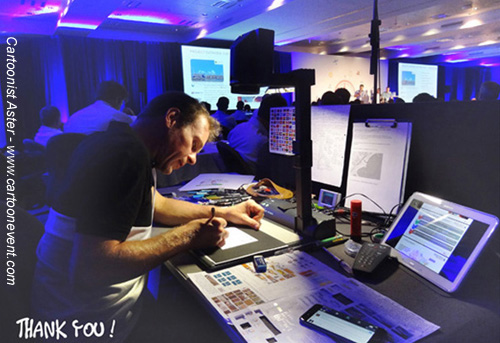Event
enhancement through drawing
CartoonEvent's
live cartooning service consists of enhancing a meeting
(workshop, seminar, business away day, conference, etc.)
using live drawings created by a cartoonist working in
the control room, at the back of the room or on the stage
who, in just a few seconds, extracts elements of the meeting
to sketch. His visual commentary will provide a touch
of humour in contexts that are often overly serious, allowing
the participants, speakers and audience to feel more relaxed
and promoting participation, attention and memorisation.
Using a cartoonist shows that the organising body has
a friendly and innovative side and is prepared to be self-deprecating
or even self-critical. .
Raw
materials
The
sources of inspiration for the cartoonist are, of course,
the speeches with their thematic content, possibly communicated
in advance, and all the forms of modulation they take
at the event, as well as the speakers' attitudes, the
audience's reaction, the speakers' notes, videos or PowerPoint
presentations and, finally, the general atmosphere, which
the cartoonist helps balance: a cartoon with a humorous
slant can temper a tense atmosphere, while a more refined
illustration (see example 1 on this page) will be well
received as a way of restoring a sense of calm and concentration
to a dissipated meeting. In addition, a symbolic illustration
will stimulate reflection, while a caricature of the speaker
will punctuate his or her conclusion and prompt further
applause. A mood drawing can be a perfect way of signalling
the transition between two focal points; a summary drawing
or illustration comparing two points of reference will
ensure a pleasant flow from one theme to the next... In
short, the whole structure of the day or session can be
improved.
Coffee
breaks
Breaks
offer an occasion to comment on the proceedings. The drawings
and, through them, the topics discussed at the meeting
or conference, can make for the most pleasant topics of
conversation. For art and humour bring people together
and allow everyone to be positive and give praise: evoking
a presentation they particularly appreciated, or talking
about the reaction of a participant to whom a drawing
was addressed. The organisers will also be congratulated
for having the great idea to invite a cartoonist like
Aster or for being daring enough to provide a very welcome
touch of humour in an atmosphere sometimes deemed too
strict or stuffy. Humour is even more effective when it
appears where we least expect it.
Effectiveness
The
effectiveness of live drawing as a communication enhancer
derives from its impact on our memory.
Firstly, drawing is a very fluid graphic form that can
be perceived by everyone: there is often no need for explanation
or translation to enjoy a live drawing or thematic illustration.
We might also be sensitive to the artistic aspects of
the 'performance' itself, which consists of drawing an
intelligent humorous situation very quickly.
Secondly, humour, conveyed here by the drawings, also
has a great mnemonic impact, partly because it calls upon
faculties other than the reasoning around which most speeches
are structured: humour creates a sense of finesse, emotion
and a reaction, which can be physical!
Thirdly, the context in which the humorous drawing is
introduced is an exclusively verbal one made up of speeches,
which can sometimes be technical and include redundant
information, supported by presentation slides overloaded
with text. Such a context can sometimes come across as
'tedious' or 'soporific'. It is therefore inevitable that
a drawing, a simple, impromptu graphic form, suddenly
displayed on a huge screen, will stand out from the general
content like a rainbow in a grey sky. Taking into account
these three elements - the impact of the graphic form,
the effectiveness of humour and their introduction into
an almost exclusively verbal and rational context - it
is not surprising that illustrations produced live are
one of the first things participants remember. The aim
for the organiser and cartoonist, working together, is
for these drawings to act like catch lines to enhance
the perception of the key messages delivered by the speakers.
Afterwards
and... ad infinitum!
The
drawings produced during an event will live on long after
it has come to an end! They are scanned, made into a useful
format for the printed press or the Web, associated with
an explanatory contextual phrase and sent to the client
'ready to use' or made available on a Web page. As for
the originals, these can be offered to speakers as thank
you gifts or awards at the end of a competition. All the
drawings can be sent to participants upon request, with
permission to use them for appropriate purposes. Finally,
the live drawings constitute an iconographic bank upon
which you can draw to enhance a report of the event, an
Intranet page, an e-mail shot, etc. (related to the event)
and re-immerse readers in the atmosphere of a convention,
seminar or event made unforgettable by a few touches of
humour.
|
©Jean-Philippe
Legrand - "aster" Reproduction prohibited.
|
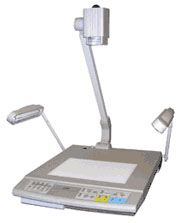
Les
avantages du cartoon en direct
A
l'instar des illustrations en communication
écrite, l'animation via les caricatures
permet de :
-
Dynamiser le contenu de façon originale
- Soutenir
l'attention et l'intérêt
du public, des spectateurs, des intervenants
- Alléger
la présentation de l'information, décontracter
l'atmosphère
- Faire
une pause, " souffler " quelques
instants... par l'art et l'humour !
- Représenter
ce dont il est question, sortir de l'abstrait
- Structurer
l'événement : en introduction
des thèmes, transition entre les intervenants
- Humaniser
la communication par la subjectivité
du dessin
- Décaler
le discours, donner un autre point de vue
(le regard extérieur, du néophyte,
de "l'artiste")
- Fixer
en mémoire certains points par
l'impact de l'image
- Insister,
transmettre une idée clé, (peut
être communiquée préalablement
au dessinateur)
- Epingler
un détail, attirer l'attention
sur ce qui aurait pu passer inaperçu
- Résumer
de longs développements ou une situation
par un dessin
- Faire
rire ou sourire le public
mais aussi l'orateur (et peut-être le
rendre plus "sympathique"!)
- Donner
une image positive de l'instance organisatrice
(capacité d'autodérision)
- Ex-primer
("évacuer la pression ")
le sentiment contenu par le public, par sa
figuration
- Oser
dire le non-dit ou poser la question naïve
ou fatale, à laquelle tout le monde
pense ou à laquelle personne n'a pensé
- Tempérer
un propos trop univoque
- Conclure
de façon positive
Utilisations
particulières, très pratiques
- Accueillir
les participants, les invités, le public
- Attirer
l'attention
- Solliciter
l'arrêt des GSM
- Rappeler
le respect du timing à l'intervenant
- Inviter
à parler plus près du micro
- Expliquer
une procédure de communication appliquée
pendant le meeting
- Rappeler
à l'ordre
de façon sympathique ·
- Annoncer
une pause, souhaiter bon appétit
- Combler
un blanc (suite à un problème
technique par exemple)
- Aider
un intervenant en difficulté, mal compris,
chahuté, perdu dans ses feuilles
- Rendre
hommage aux absents
- Remercier
les participants de façon originale
- Communiquer
un site web de référence
ou une adresse e-mail à noter
- Inviter
au verre de l'amitié
- Disposer
d'un ensemble d'illustrations pour un éventuel
compte rendu ou
- Offrir
un cadeau ou une
récompense aux participants : caricature,
dessin original,...
Dans
le cas d'un événement moins protocolaire
:
- Amuser,
apporter l'humour, le rire, la surprise, une
touche d'originalité
- Favoriser
la communication (les dessins suscitent
réactions, déplacements,...)
- Encourager
une certaine décontraction dans des
circonstances parfois "guindées"
- Rassembler
les participants autour d'un dessin (à
réaliser avec eux par exemple)
- Offrir
le plaisir de se voir "croquer"
ou de voir "caricaturer" un proche
- Réaliser
les souhaits, exécuter les
demandes des convives, participants ou invités
- Laisser
un souvenir (les dessins sont offerts)
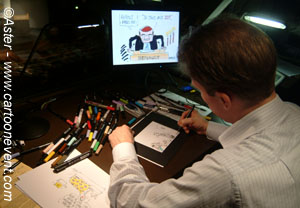
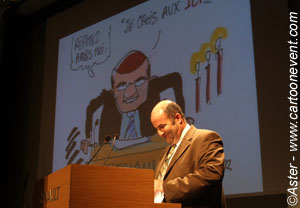
|
|
|
|
